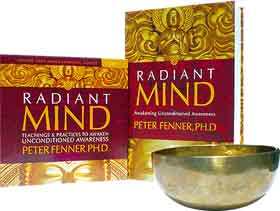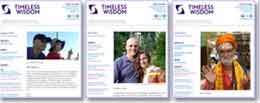by Peter Fenner
How much time do you spend wondering what is the best thing for you to be doing in the present moment, or at some time in the future, or what you should have differently in the past? How often have you mulled over, or even struggled with the question of finding the right career, the most enriching relationship, the best diet, or the most rewarding thing to do with your free time? At a more micro level I’m sure the following thoughts are also very familiar to you: “Should I go home now, or work longer?” “Should I get more advice, or just make a decision to do something?” “Should I speak with them about this concern, or just keep it to myself?” It is clear that we expend a lot of energy trying to work out what is the best thing for us to be doing with our time. Our concern with finding the best thing to be doing naturally translates into our spiritual lives. We ponder: “Should I try to control my thoughts, or just let them be, however they are?” “Should I read another book about my practice, or just get down and do it?” “Should I take the time out to do a retreat, or spend time with my family?” “Should I find another teacher, or continue with the one I have?” “Should I continue to meditate, or have a break?” “Should I keep searching for a better practice, or just be satisfied with what I am doing?” In short, we invest a lot of energy in looking for the “best practice.”
Of course, as soon as we ask “what is the best practice” this raises the question, best for what? It is impossible to ponder the question of “what is the best thing to be doing”, without this revealing our goals in life, since our intention in discovering the “best practice” is to arrive at our desired goal as quickly and efficiently as possible. The best way to do things always depends on what we want to achieve. For example, if we are committed to the creative role of intimate relationships in spiritual development, then becoming a monk or nun would severely limit our opportunities for growth. If we want to achieve union with God, then there would be no point in becoming deeply involved in a non- theistic tradition like Buddhism.
Normally we take the idea that there is a best, or at least better practice, for granted. However, in our own work we question this assumption. We question the amount of time spent trying to deter- mine the best thing for us to be doing. Our reasons for doing this are twofold. Firstly, if we inquire into the notion of a “best thing to be doing” it is difficult, and perhaps impossible, to discover such a thing. It could be that the notion of a “best practice” is just that-a concept. Secondly, our need to find a “best practice” very often diverts attention and energy away from simply being present to our experience in a fresh and non-evaluative way. At its extreme, the need to find something different and better can become a fanatical search for the fastest and most direct path to enlightenment. Our endeavor to discover “the best thing to be doing” also creates confusion, since we have often discov- ered what we think is the best teacher, the best tradition, etc. only to find that it isn’t the best, and that we have to start our search all over again. So let us look at the concept of a “best practice” more closely. If there is a best thing to be doing for our spiritual development, there seem to be only two possibilities. The best thing to be doing is either what we are presently doing, or something else.
Very often, we think that the best thing to be doing is something different than what we are presently doing. However, if the best practice to be doing differs from what we are already doing it is impossible to do this, because the possibility of doing it is displaced by what we are presently doing. The best practice is simply a hypothetical speculation about what we could do some time in the future. In fact, there are probably times when our present practice consists mainly of wondering what better practice we could be doing. In other words, our practice is to construct what it is that we should be doing, and aren’t doing!
At this point it might be tempting to say that the best practice is the one we are doing, since this is the only one we can actually do. A “best practice” can hardly be something that it is impossible to do! But, if the best practice is simply doing what we are already doing, then our concern with finding a best practice need go no further. There is nothing more for us to do, or think about, since there can never be a time when we aren’t doing the best thing we could be doing. However, because we can’t be doing something other than what we are doing, it no longer makes sense to call this a “best practice”. The idea of a “best activity” implies that we could be doing a less useful, or less construc- tive action, which we surely can’t be doing if we are doing what we are doing. To say that our present practice is the best one because we can’t physically be doing another one is a little like claiming that it is best to have two eyes rather than three or four.
If we take issue with interpreting this question in terms of what we are doing right now, then the best practice is something we are considering doing in the future. We aren’t wanting to employ any suggested practice right now. Rather, we are seeking information that may be helpful to us in the future. From our point of view, this isn’t what we usually mean by “engaging” in the best practice, since the best practice is something that we do rather than merely think about. If we understand the idea of “best practice” as simply the acquisition of some ideas for fueling our speculations about what to do in the future, its value is purely hypothetical for it only exists as a discourse about what we will, or will not do. As a practice that can impact our lives right now, it consists of a story about what we may or may not do tomorrow, next week or next year.
In conclusion, then, the “best practice” is either no practice, or at best a story about what we may or may not do.
The second reason why we don’t cultivate the idea of a best practice is that the search for such a practice can take us away from what we are presently doing. Often we ask the question: “What is the best thing I could be doing?” in a mood of purely theoretical inquiry with no intention of acting on any suggestion. At other times the question is asked with an earnestness that masks our commitment to keep on doing pretty much what we are already doing. Embedded within the question is the implication that we can radically change what we are doing at the drop of a hat. We give the impres- sion that were we convinced of the value of feeling X, or doing Y, we would do this immediately. Our subsequent failure to make any change is then justified on the grounds that we are not convinced of the value of the change, even when this is beneficial to our well-being. This attitude disregards the facticity of our present condition and displays a blindness about our need to seek change and capac- ity to stay the same.
Finally, we should clarify that in challenging our everyday assumption that there is a “best thing to be doing”, we are not suggesting that all practices are equal. In our work, we don’t buy into the notion there isn’t a best thing to be doing, since this belief can give licence to very slack and undis- criminating approach to spirituality. In other words, we don’t collude with people’s interpretation that they are getting things right, or wrong. In this way we are able to invite people into a space that simultaneously transcends our preoccupation with getting it right, and heightens our appreciation of the immediate consequences of our actions.



